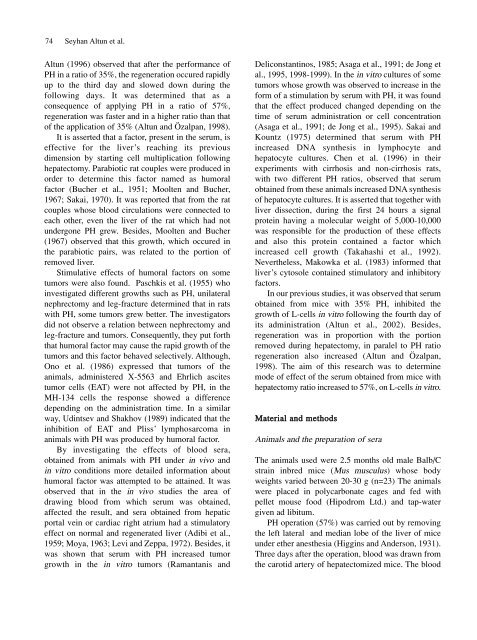Full Journal - Journal of Cell and Molecular Biology - Haliç Üniversitesi
Full Journal - Journal of Cell and Molecular Biology - Haliç Üniversitesi
Full Journal - Journal of Cell and Molecular Biology - Haliç Üniversitesi
You also want an ePaper? Increase the reach of your titles
YUMPU automatically turns print PDFs into web optimized ePapers that Google loves.
74 Seyhan Altun et al.<br />
Altun (1996) observed that after the performance <strong>of</strong><br />
PH in a ratio <strong>of</strong> 35%, the regeneration occured rapidly<br />
up to the third day <strong>and</strong> slowed down during the<br />
following days. It was determined that as a<br />
consequence <strong>of</strong> applying PH in a ratio <strong>of</strong> 57%,<br />
regeneration was faster <strong>and</strong> in a higher ratio than that<br />
<strong>of</strong> the application <strong>of</strong> 35% (Altun <strong>and</strong> Özalpan, 1998).<br />
It is asserted that a factor, present in the serum, is<br />
effective for the liver’s reaching its previous<br />
dimension by starting cell multiplication following<br />
hepatectomy. Parabiotic rat couples were produced in<br />
order to determine this factor named as humoral<br />
factor (Bucher et al., 1951; Moolten <strong>and</strong> Bucher,<br />
1967; Sakai, 1970). It was reported that from the rat<br />
couples whose blood circulations were connected to<br />
each other, even the liver <strong>of</strong> the rat which had not<br />
undergone PH grew. Besides, Moolten <strong>and</strong> Bucher<br />
(1967) observed that this growth, which occured in<br />
the parabiotic pairs, was related to the portion <strong>of</strong><br />
removed liver.<br />
Stimulative effects <strong>of</strong> humoral factors on some<br />
tumors were also found. Paschkis et al. (1955) who<br />
investigated different growths such as PH, unilateral<br />
nephrectomy <strong>and</strong> leg-fracture determined that in rats<br />
with PH, some tumors grew better. The investigators<br />
did not observe a relation between nephrectomy <strong>and</strong><br />
leg-fracture <strong>and</strong> tumors. Consequently, they put forth<br />
that humoral factor may cause the rapid growth <strong>of</strong> the<br />
tumors <strong>and</strong> this factor behaved selectively. Although,<br />
Ono et al. (1986) expressed that tumors <strong>of</strong> the<br />
animals, administered X-5563 <strong>and</strong> Ehrlich ascites<br />
tumor cells (EAT) were not affected by PH, in the<br />
MH-134 cells the response showed a difference<br />
depending on the administration time. In a similar<br />
way, Udintsev <strong>and</strong> Shakhov (1989) indicated that the<br />
inhibition <strong>of</strong> EAT <strong>and</strong> Pliss’ lymphosarcoma in<br />
animals with PH was produced by humoral factor.<br />
By investigating the effects <strong>of</strong> blood sera,<br />
obtained from animals with PH under in vivo <strong>and</strong><br />
in vitro conditions more detailed information about<br />
humoral factor was attempted to be attained. It was<br />
observed that in the in vivo studies the area <strong>of</strong><br />
drawing blood from which serum was obtained,<br />
affected the result, <strong>and</strong> sera obtained from hepatic<br />
portal vein or cardiac right atrium had a stimulatory<br />
effect on normal <strong>and</strong> regenerated liver (Adibi et al.,<br />
1959; Moya, 1963; Levi <strong>and</strong> Zeppa, 1972). Besides, it<br />
was shown that serum with PH increased tumor<br />
growth in the in vitro tumors (Ramantanis <strong>and</strong><br />
Deliconstantinos, 1985; Asaga et al., 1991; de Jong et<br />
al., 1995, 1998-1999). In the in vitro cultures <strong>of</strong> some<br />
tumors whose growth was observed to increase in the<br />
form <strong>of</strong> a stimulation by serum with PH, it was found<br />
that the effect produced changed depending on the<br />
time <strong>of</strong> serum administration or cell concentration<br />
(Asaga et al., 1991; de Jong et al., 1995). Sakai <strong>and</strong><br />
Kountz (1975) determined that serum with PH<br />
increased DNA synthesis in lymphocyte <strong>and</strong><br />
hepatocyte cultures. Chen et al. (1996) in their<br />
experiments with cirrhosis <strong>and</strong> non-cirrhosis rats,<br />
with two different PH ratios, observed that serum<br />
obtained from these animals increased DNA synthesis<br />
<strong>of</strong> hepatocyte cultures. It is asserted that together with<br />
liver dissection, during the first 24 hours a signal<br />
protein having a molecular weight <strong>of</strong> 5,000-10,000<br />
was responsible for the production <strong>of</strong> these effects<br />
<strong>and</strong> also this protein contained a factor which<br />
increased cell growth (Takahashi et al., 1992).<br />
Nevertheless, Makowka et al. (1983) informed that<br />
liver’s cytosole contained stimulatory <strong>and</strong> inhibitory<br />
factors.<br />
In our previous studies, it was observed that serum<br />
obtained from mice with 35% PH, inhibited the<br />
growth <strong>of</strong> L-cells in vitro following the fourth day <strong>of</strong><br />
its administration (Altun et al., 2002). Besides,<br />
regeneration was in proportion with the portion<br />
removed during hepatectomy, in paralel to PH ratio<br />
regeneration also increased (Altun <strong>and</strong> Özalpan,<br />
1998). The aim <strong>of</strong> this research was to determine<br />
mode <strong>of</strong> effect <strong>of</strong> the serum obtained from mice with<br />
hepatectomy ratio increased to 57%, on L-cells in vitro.<br />
Material <strong>and</strong> methods<br />
Animals <strong>and</strong> the preparation <strong>of</strong> sera<br />
The animals used were 2.5 months old male Balb/C<br />
strain inbred mice (Mus musculus) whose body<br />
weights varied between 20-30 g (n=23) The animals<br />
were placed in polycarbonate cages <strong>and</strong> fed with<br />
pellet mouse food (Hipodrom Ltd.) <strong>and</strong> tap-water<br />
given ad libitum.<br />
PH operation (57%) was carried out by removing<br />
the left lateral <strong>and</strong> median lobe <strong>of</strong> the liver <strong>of</strong> mice<br />
under ether anesthesia (Higgins <strong>and</strong> Anderson, 1931).<br />
Three days after the operation, blood was drawn from<br />
the carotid artery <strong>of</strong> hepatectomized mice. The blood

















